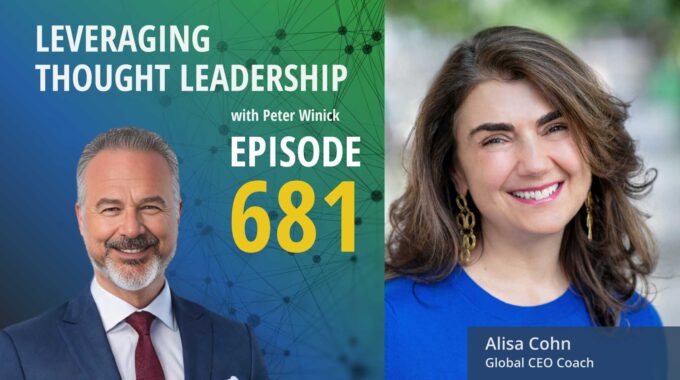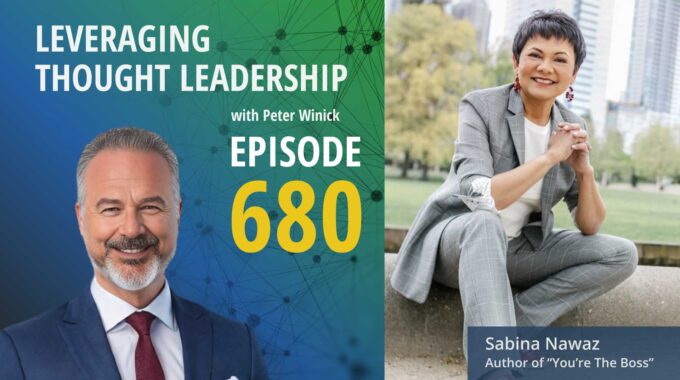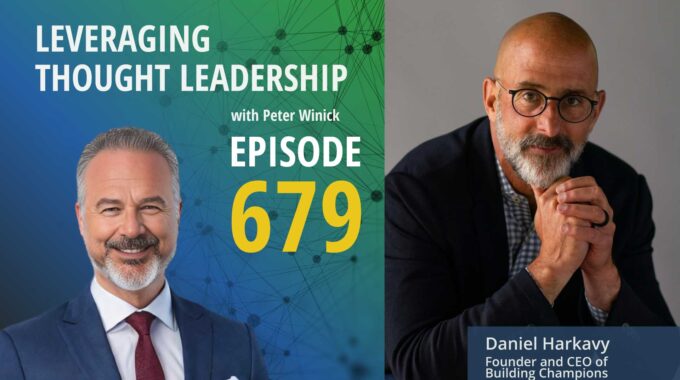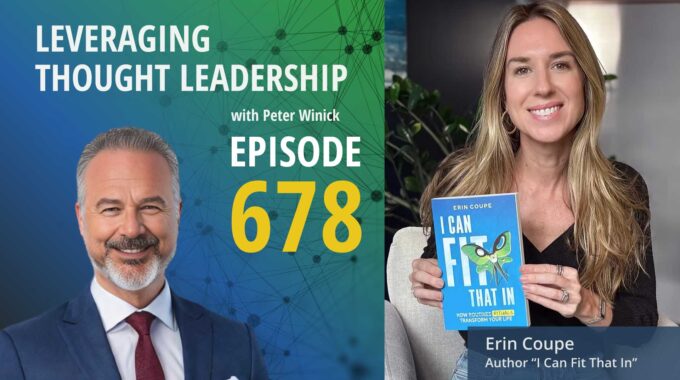Coaching at the Top, Leveraging AI, and Playing the Five-Year Book Game This episode explores…
Using Clear, Effective, Thought Leadership Marketing | Dolores Hirschmann
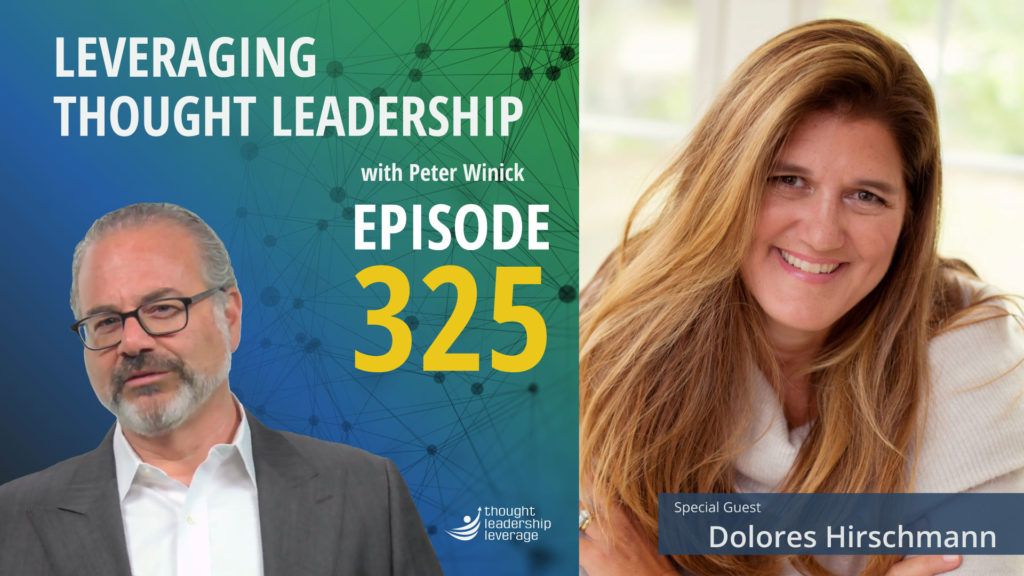
How proper coaching can create more impactful actions.
An interview with Dolores Hirschmann about applying coaching skills to marketing and the fear of failure.
Today’s guest on our podcast is Dolores Hirschmann. Dolores is well known for organizing TEDx conferences, and is also the author of Clarity First, a recently published book that helps people find the clarity they need to grow their business. She has deep experience in marketing, and has blended coaching into her unique approach for helping businesses scale. We are so excited to spend some time talking to her!
Dolores uses her time as a TEDx organizer to delve into the way many brilliant minds lack the succinctness needed to deliver their message. Too often, great leaders get tangled in the details, and can’t connect in a way that gets others to lean forward and buy-in. By applying her knowledge of coaching skills to marketing tactics, she has enabled countless leaders to read between the lines of conversation – and strike upon the best ways to share the parts of their leadership that really matter most.
However, clarity isn’t the only struggle. Even leaders who instinctively grasp clarity often still struggle to make an impact. Some fight the fear of failure, and others find themselves facing fear of success and “what-happens-next?” Dolores discusses the way these fears are two sides of the same coin, and how to overcome them. In today’s conversation, we explore self-worth, self-doubt, and how to change your mindset. You can create a new way forward, build your confidence and assuredness, and give yourself the permission to succeed.
If you have ever had the nagging fear that you weren’t enough, or that you were just muddling through when you could be winning, this episode can help you realize and accept your full potential. You can do it, and Dolores Hirschmann’s Clarity First can get you there!
Three Key Takeaways:
- If your Thought Leadership lacks clarity, the greatest potential of your insights will be hidden behind a messy message.
- Once you find clarity in your Thought Leadership, you need to take action to create impact.
- Even things you consider failures can drive success! Take a moment to study challenges, learn from them, and use those lessons to shape a better way forward.
If you need a strategy to bring your thought leadership to market, Thought Leadership Leverage can assist you! Contact us for more information. In addition, we can help you implement marketing, research, and sales. Let us help you so you can devote yourself to what you do best.
Transcript
Peter Winick And welcome, welcome, welcome, this is Peter Winick, I’m the founder and CEO of Thought Leadership Leverage, and you’re joining us on the podcast today, which is Leveraging Thought Leadership today. My guest is the Dolores Hirschmann. Dolores has a pretty cool title. She is the chief clarity officer, which I love. She works with speakers, entrepreneurs, authors and executives to clarify their messages. She works with early and mid-stage growth companies, works with folks on their 10x work. She’s a coach. She’s a speaker, digital marketing and membership expert and a bunch of other cool things. So let’s just dive in and I think you’re the first chief clarity officer I’ve ever spoken to you, so do I address you as Your Highness or how does that work?
Dolores Hirshmann I hope so.
Peter Winick Right, right. So who comes to you and what are they hoping to to achieve? Because.
Dolores Hirshmann Yeah, they come to me. Because they feel that their potential is stuck behind a very messy message. They are not gaining traction. Whatever they’re doing out in the world, speaking, posting, you name it, it feels blah to them and they feel that, you know, you know, when you see all the other people doing exactly the same work you’re doing, but gaining momentum and doing, you know, exponentially. And you say, that’s exactly what I do. Why can’t I do it?
Peter Winick So stay there for a minute. Because I think that people are always looking for the five steps to what’s the template or what’s the whatever. And I think the reality is it’s, you know, somebody could be doing these five things consistently, whatever, and they’re killing it and you do it. And it’s horrible, right? And there’s lots of reasons it might be who you’re trying to reach. How are you trying to reach them? The fuzziness, the noise. And I think what’s really important today is we, you know, attention is the most scarce resource we have, right? It’s not necessarily money, it’s not energy or whatever. And if you don’t grab on by the collar and shake them up really, really quickly, they’re just rolling and you’re just dealing with like, next, next, next, next. And it’s not so easy to grab their attention without sort of lighting your hair on fire.
Dolores Hirshmann Exactly. And so in my background, in my training, I’m a coach, I’m a life and executive coach and I’m a marketer part of it. I went back to school to study coaching because I had lost myself. And in that process, I realized the need of the coaching skills into marketing because why are we not getting people’s attention? Because we’re talking about a product, we’re not talking about our customers, we’re not leading with being in their shoes with what they’re feeling, what they’re experiencing. You know, you’ve heard it many times we have to lead with their pain point.
Peter Winick Well, an expert, so I, you’re preaching to the choir because I think sometimes the problem is an expert is – they’re so deep in their stuff that they need to pause and say, Wait a minute, why would anyone care? Like, you know, I have clients all the time come to us. Well, what do you work out the leadership of medical, whatever? And I’ll say to them in a fairly snarky way, you know, the world doesn’t need another leadership book. You know, how is your leadership book or your thinking or whatever? Getting people to think about a specific group of people to think about a specific pain point that they have in a new, better or a different way. And then if they look at you sort of glazed over, you know, you have a problem.
Dolores Hirshmann Exactly. And so for me, that realization of the need in the market came when I volunteered as a TED organizer and one of the largest directors in the East Coast. I, you know, back then, I mean, we all knew tracks. I didn’t know the insights of the process and then, you know, the competitive side of it as a speaker. Sure, sure. So we were getting three 400 applications and we only open to applications for a limited time. And we’re getting three to 400 applications for 16 slots on the stage.
Peter Winick Wow.
Dolores Hirshmann And application after application, you know, there was one question that we asked consistently, which was what is your idea worth sharing? And when I got an answer that was three paragraphs long, they were disqualified before I read it, because if you can answer that in one short sentence and then the next question is like, why do we care? It literally was one of the world’s greatest idea. Right now we ask that question, and I know I know five paragraphs of answers gone and I wouldn’t even read it. So there’s a lack of clarity. Lack of clarity will lead to lack of syntax and straightforwardness and lack of engagement.
Peter Winick So I, in my work with clients, tackle the same problem. But I get there in a little bit different way than you do. Right. So the way I get there is, you know, we start by working with our clients and developing their strategy because most authors, Thought Leadership Leverage, et cetera, either don’t have a cutting edge strategy or the one they have is antiquated or they don’t have one at all, or it hasn’t been updated, whatever the case is. And so I’ll talk to them about our process and the cost of all that stuff and why, you know, what do we really need that? I’m like, it’s really two words clarity and the ability and prioritization, right? So at the end of this process, you will have clarity. Once you have clarity, it becomes far easier to prioritize what could I do? What I do? Should I do because I work, as do you with really smart people. And I think smart people, most of the time, they’re active, they’re busy, they’re doing stuff. But it’s not necessarily the right things in the right sequence to get to the right outcomes. And it’s an inefficient use of energy, opportunity, cost, etc. So I think you and I are sort of tackling the problem in a little bit different ways. So I love how you’re playing coaching skills for marketing. So tell me play with that a little bit because I mean, I get coaching. You know, coaches are a dime a dozen. The coaches that apply coaching skills to marketing that got me leaning in and going, Tell me more.
Dolores Hirshmann Yeah. So I mean, my background is I graduate from university in business and marketing, and that’s been my work. Coaching opened up a whole world. It opened up to me, everything that’s not said with what. So and the reason, let me be clear, why did I go and became a certified coach because I was a consultant? I would talk strategy until people were blue in the face and make them do it. They had the strategy, they had the plan and there was a leadership problem and there was an engagement problem. And so what coaching uncovered for me is a capacity. I call it a superpower. Read what’s not sad to hear? What’s not, you know, what’s not in the conversation? And when you’re able to listen to your market, to listen to your needs, to listen to your clients, from that perspective, you can communicate and verbalize what nobody else can.
Peter Winick So I love that because it’s not about an inability to be articulate. And, you know, it’s not the value proposition of the elevator pitch, because we’ve all heard that stuff.
Dolores Hirshmann And we need that anyway.
Peter Winick But yeah, but those are sort of table stakes. But what is your market telling you, but not in words, is basically what you’re saying. What are what are your I’m always trying to think about, well, what are the things that keep your clients up? What are the things that they’re worrying about? And they might not have the language. They might not have the courage, they might not have. The words to say are what I’m worried about is being thrown, you know, being left for idle and a digital transformation or whatever it is. So how do you how do you sort of prod that out? Because I think the part of that is a consulting skill to be able to it out. Well, tell me what you mean by that. We want to go down the therapy path, but how do you how do you get the prospects or the clients or the folks you want to serve? Tell you what they’re actually in pain about.
Dolores Hirshmann Yeah. So you nailed it -. It’s not that complicated, right? But it’s listening more than talking, opening open ended questions, not yes and no questions and giving them enough guidance for them to come up with answers, for example, is like, Well, I can’t, you know, my launch failed. OK, tell me more. Mm hmm. What part of it failed? Where did you feel that you succeeded? Where do you feel? What were you experiencing throughout, like nearly digging like a coach would on any experience at your, you know, rate sharing? And so the other thing is, when we are communicating, once we are able to capture what’s not said the way we communicated, you know, we can capture the experience of the client and how they’re feeling, and we can be clear as strategies, what they’re experiencing. But then when we say back to them, we actually have to go like reverse engineering twice. We hear what the client says. We translated and then we have to reverse engineer that with. What does that mean in the real world? The frustration is not a pain point. It is, but it’s too broad. Frustration is a pain point, but not getting clients is a real, tangible
Peter Winick Right, frustration’s more of a state of mind or a symptom. Right. We’re not. Most of us around the business of solving the problem of frustration. So I think sometimes it’s going one more question what is it that you like? Yeah. Or even like you said, the launch failed. Well, that’s a binary way of thinking. There’s probably elements of the launch that didn’t fail. Maybe the copy was great. Maybe this is give me, you know, maybe it failed because you didn’t get enough clients or they were, you know, we tend to call an entire thing a failure. And think in black and white terms. And it’s like, wait a minute, if you were to do it again, would you throw out all of it? Or there were just these three little things you would fiddle with?
Dolores Hirshmann Exactly. And that’s where we can really assess for of. I had a client who at the launch failed and then we broke it down, and it really is like my message was blah. It came down to this there was no sticky point at the beginning of the not so good did come through actually convert it so that her conversion was amazing if she had done more stickiness at the front end.
Peter Winick If you’re enjoying this episode of Leveraging Thought Leadership, please make sure to subscribe. If you’d like to help spread the word about our podcast, please leave us a review and share it with your friends. We’re available on Apple Podcasts and on all major listening apps, as well as at Thought Leadership Leverage dot com forward slash podcasts.
Peter Winick Got it! And as a result of gaining the clarity, so let’s look at the other side, right? It’s about sort of ideas and impact, right? So you’ve got the clarity and most people. I have a a desire to achieve impact, and the impact could be intrinsic, it could be extra whatever it is, right, there’s different ways of different folks measure that. But clarity is sort of the precursor, right? So once you once you help them get that, the clarity that they need, does it all just flow into place or give me something?
Dolores Hirshmann Yes and no. I mean, we need to try so. So I always talk about clarity, action, impact, clarity, action, impact, repeat. And I, you know, I use a metaphor the analogy of when we drive at night 60 70 miles per hour on the highway. So the clarity we have in the middle of the night, no more night is our headlights. And we still are taking action. And I’m moving really fast, trusting that the clarity or that our car will show us the way for another mile. And I don’t know how far should shine. So I always say, you know, clarity without action is useless. Action without clarity is spaghetti to the wall is a consequence of the combination of clarity and action.
Peter Winick So when or lack thereof, right?
Dolores Hirshmann Yeah. And so and so when you have clarity, when you’re not going to have clarity where everything that you’re questioning in your life, but you have enough clarity to take assertive action versus
Peter Winick stay there for a minute, because I think that’s a key point. And there are certain types of individual, they tend to be more technical, et cetera, where there’s an insecurity. So it’s always, I need more data, I need more data. I need more data. Right. So you’re never going to get to a world where you have, you know, whatever the analogy, you know, 2020 perfect clarity and you can see exactly what needs to be done. So how do you get folks to maybe want too much clarity? You know, like, you know, you and I are both sitting here where this is going to be perfect clarity. So we need to know we can function in a world with glasses, and maybe it’s less than perfect, but it works. It works.
Dolores Hirshmann Yeah, you’re talking about analysis paralysis, right?
Peter Winick Yeah, yeah, exactly.
Dolores Hirshmann So that’s the beauty of my work here, because there’s a point where you don’t need a strategist to give you more clarity. You actually need a coach. And we go into conversation of self-confidence, self-worth, self-doubt, and we go into that coaching experience of learning how to trust yourself. So that’s the beauty of it.
Peter Winick So let’s stay there because I, you know, was the strategist now says to the coach, I hear that, and it makes a lot of sense to me because there I’ve had over my years lots and lots of clients right where we’ve killed it. On the strategy side, we know with certainty. This is a great strategy. And now, I mean, you know, all you have to do is execute not all you have to do because it’s easier said than done. But there are these. Emotional what excuses? I see people that like they will rearrange the spice drawer 32 times before doing the first action item, that is the clear thing they need to do, and that’s outside of my domain. At that point, I’m like, You need it, you need a coach or a shrink or whatever, because step one committee in the car and start it. That’s how you started part.
Dolores Hirshmann That’s where I was before going to coaching school. I was in that room of perfect strategy, no action or no consistent action. Go back to coaching or go into coaching. Learn those skill sets. And now I bring that. So here’s what happens. There’s such thing as fear of failure. And there’s such a thing as fear of success.
Peter Winick Yes. Yes.
Dolores Hirshmann And they are the same, that different set of same coin. And so you have to go into conversations like what happens if this works?
Peter Winick What will you either stay there a minute or so I’m processing that because I used to think that fear of failure and fear of success were different. And as I’m thinking through that in my city, mental Rolodex here, it’s interesting. I think I’m buying that, but I’m not sure. So to me, the fear of failure might be imposter syndrome. The fear of success is, Oh, now what to tell me why they’re not different
Dolores Hirshmann at the fear of failure? You say they fear of failure. And so I went to flop and everybody will ever will see that I’m a fake. OK. Fear, failure, fear of success. So here’s the thing we all have like right now I have imposter syndrome. You have syndrome with a tiny level. And actually, it’s a good thing because it keeps us honest. It keeps us like learning and
Peter Winick the you get complacent going, Oh geez, I can’t be here to be here. Exactly.
Dolores Hirshmann So. So there’s always a level that we all have, and it’s a good thing. But when that is not tackled or there’s no awareness or there is no self-management of that. Think of it. The higher I climb, it’s ultimately fewer. Success is fear of ultimate failure because it’s says delayed failure fear. So the more I climb, the more I will fall when I actually fail, because there’s something in my belief system. Sure. For whatever reason, that ultimately, I’m not good enough.
Peter Winick So is it that the way I see it now, I’m not a coach is I just observe, right? Like, OK, that’s really self-sabotage. The fact that they won’t do this or they will do that or they do these awful things is the self-sabotaging the symptom or the you.
Dolores Hirshmann It’s what self-sabotage is the behavior that enables that. So there is a fear. Yep, that that is. So there’s a belief system of things about yourself that you believe for whatever reason. Sure. Which feeds a fear like, I believe that I’m not good enough. So I am going to be afraid of certain exposing myself in certain ways. Sure. And so so in order not to believe fear behavior. So let me give you a perfect example. Personal experience a few years ago. I have to have fear of failure of success, right? The higher you climb. And I had a team that was really good. I got in the room, I got in their way. I spent a lot of money of your own team. I saw a lot of money with that vendor. And I question every step. And I was I became uncomfortable. I’m being honest. And thinking back and they were great guys, and I would recommend them. We were not successful together. Sure. Because there was something that I. And maybe there was something on them too. But on my side, I was little bit in a panic mode because I had this feeling that, Oh my god, this is going to work right one.
Peter Winick All right. So is the fear which leads to paralysis could be the same, whether it’s utter failure. And you know, this is the impostor syndrome where this isn’t going to happen and all of a sudden I’m homeless. And then there’s the other side of, Oh my god, this is going to work and I’m going to be in.
Dolores Hirshmann So for me, I mean, I’m going to be brutally honest and this, you know, I’ve worked on this for many years now, longer my belief system. But early on, you know, I am married. I have four wonderful children. I said, OK, if this really takes off the way I’m imagining it, will my husband stay? Will I be about mom, right? My will my children turn out OK? Will the demand of that success take me so much time? They’ll neglect my children and they’ll. My success will be to our failure. You know, you can rationalize all my rationality if you want. There was no rationalization because at the end of the day, I have a great marriage. We have partners and we want one visit visitor one support. It’s fine. In my in immature entrepreneur mind 10 years ago. That was my thought process.
Peter Winick That’s interesting. And by the way, any of those things may happen, and they may be totally unrelated to you.
Dolores Hirshmann Or related. I don’t know. It doesn’t matter. It is. You are. You are holding yourself back because of beliefs that you have based on your parents or your childhood that may or may not come true. And in that process, you are doing this. You are you are going, come clients come. Well, not, don’t come, don’t come. Come, come come. But don’t come, don’t come.
Peter Winick It’s do the marketing to get the phone to ring and then don’t answer the phone. Right.
Dolores Hirshmann Exactly! But that happens all the time. How many? I have clients who say, Well, yeah, I have three people who request my services, but I was too tired yesterday to answer. And today I’m too busy. I’ll answer tomorrow. Yeah. Well, then your marketing is working. Your conversion is up. Is rising the phone?
Peter Winick Exactly. Well, this has been great and I love this. This sort of a different a little bit of a different area for us to be exploring. But this intersection of. Were the boundaries between strategy and coaching, and it’s not binary, and that the strategy gives you clarity and coaching gives you clarity with respect to execution and implementation. And you know, my conclusion is you need both, but I might be biased.
Dolores Hirshmann So, yeah, I mean, so here’s the thing in order to grow the business you want to grow, you need to become the person you that that business needs. So entrepreneurialism? Well, any experience that you really push yourself beyond your comfort zone? It’s a journey of personal development. So when you can walk that journey with the right strategy and someone that is holding your personal development space now, you will be ready for that success. Like, yep, think about that people who win the lottery. And they it’s gone within years, because.
Peter Winick That’s pretty common when you look at the research, it’s pretty they get back to the baseline of
Dolores Hirshmann Because they have a default behavior.
Peter Winick Right, right.
Dolores Hirshmann And they have a belief of poverty or of lack.
Peter Winick Scarcity.
Dolores Hirshmann Of — scarcity. And so they can’t handle the abundance. Who they are is not an abundance personality.
Peter Winick Right.
Dolores Hirshmann So they need to make that true again.
Peter Winick Well, this has been great. I appreciate your time and I appreciate your insights. We could go for hours. This has been fantastic. Thank you so much.
Dolores Hirshmann Thank you for having me.
Peter Winick To learn more about Thought Leadership Leverage, please visit our web site at ThoughtLeadershipLeverage.com to reach me directly. Feel free to email me at Peter at ThoughtLeadershipLeverage.com and please subscribe to Leveraging Thought Leadership on iTunes or your favorite podcast app to get your weekly episode automatically.



